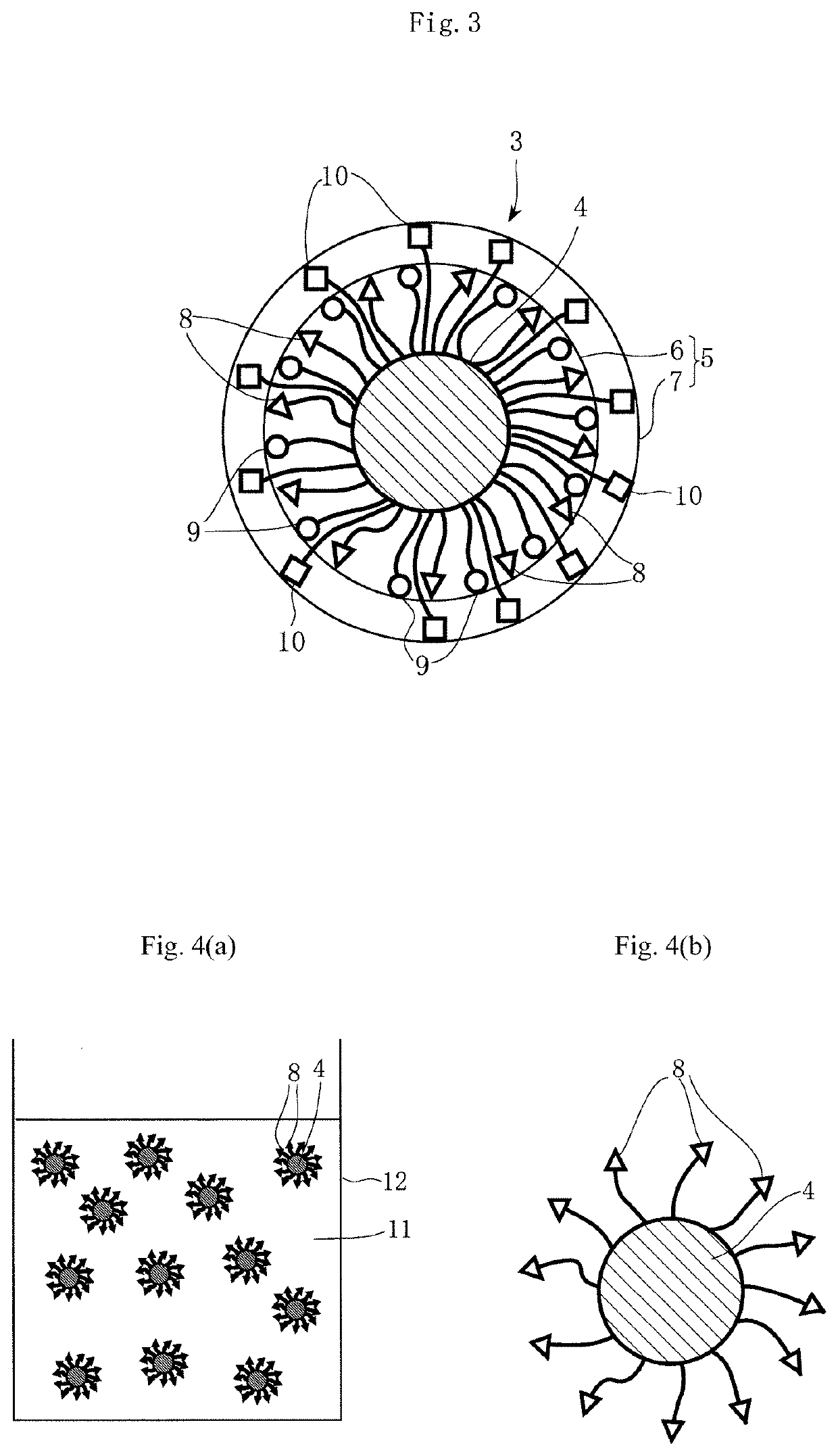Light-emitting body, method for producing light-emitting body, and biological material labeling agent
a technology of light-emitting bodies and biological materials, which is applied in the direction of material analysis through optical means, instruments, selenium/tellurium compounds with other elements, etc., can solve the problem of not being suitable for cell-targeting light-emitting bodies for bioimaging, and achieve high luminous efficiency, good emission spectral characteristics, and efficient analysis
- Summary
- Abstract
- Description
- Claims
- Application Information
AI Technical Summary
Benefits of technology
Problems solved by technology
Method used
Image
Examples
first embodiment
[0101]FIG. 1 is a schematic view of a light-emitting body according to an embodiment (first embodiment) of the present invention dispersed in water.
[0102]A container 1 contains water 2, and a light-emitting body 3 is dispersed in the water. More specifically, the light-emitting body 3 has a transmittance of 90% or more in the wavelength range of 1000 to 1100 nm in a transmission spectrum and has a good dispersion state in water without aggregation or the like.
[0103]The light-emitting body 3 contains a nanoparticle 4 of a AgInSe compound semiconductor containing a Ag component, an In component, and a Se component, and a film 5 to which hydrophilicity is imparted by ultrasonic irradiation is on the surface of the nanoparticle 4. The film 5 has a double structure having a first organic molecular film 6 containing at least an alkylthiol and a second organic molecular film 7 composed mainly of a fatty acid with a plurality of alkyl groups.
[0104]The light-emitting body 3 has an emission q...
second embodiment
[0169]The nanoparticle 4 in the first embodiment is formed of the AgInSe compound semiconductor, whereas the nanoparticle 4 in a second embodiment is formed of a AgInGaSe compound semiconductor in which a Ga component is introduced into a AgInSe compound semiconductor.
[0170]The AgInGaSe compound semiconductor has slightly higher band-gap energy than the AgInSe compound semiconductor, has an absorption edge shifted to the short wavelength side, and can emit light at a shorter wavelength in the near-infrared region while maintaining a half-width ΔH of 100 nm or less. In particular, the blend ratio of Ga to In, that is, the Ga / In ratio can be changed to control the emission intensity peak wavelength without changing the average particle size.
[0171]The method for producing a light-emitting body according to the second embodiment is the same as in the above embodiment except that a Ga compound in addition to the Ag compound and the In compound is dissolved in a solvent to prepare a Ag—In...
third embodiment
[0173]FIG. 10 is a schematic cross-sectional view of a third embodiment of a light-emitting body according to the present invention.
[0174]In the third embodiment, in addition to the first embodiment, the film 5 is covered with a surface modifier 31 composed mainly of a cationic cell-penetrating peptide.
[0175]The cationic cell-penetrating peptide is attracted to a negatively charged cell membrane on the surface of a biological material by electrostatic interaction, as described later, and a light-emitting body 32 can be easily introduced into the biological material by endocytosis. Thus, various types of biological information can be detected only by irradiating the light-emitting body 32 with light.
[0176]Furthermore, unlike Cd compound semiconductors, a AgInSe compound semiconductor serving as a light source of the light-emitting body 32 has low toxicity. Thus, even a larger amount of the light-emitting body introduced into a biological material causes less cell death and can succes...
PUM
 Login to view more
Login to view more Abstract
Description
Claims
Application Information
 Login to view more
Login to view more - R&D Engineer
- R&D Manager
- IP Professional
- Industry Leading Data Capabilities
- Powerful AI technology
- Patent DNA Extraction
Browse by: Latest US Patents, China's latest patents, Technical Efficacy Thesaurus, Application Domain, Technology Topic.
© 2024 PatSnap. All rights reserved.Legal|Privacy policy|Modern Slavery Act Transparency Statement|Sitemap



